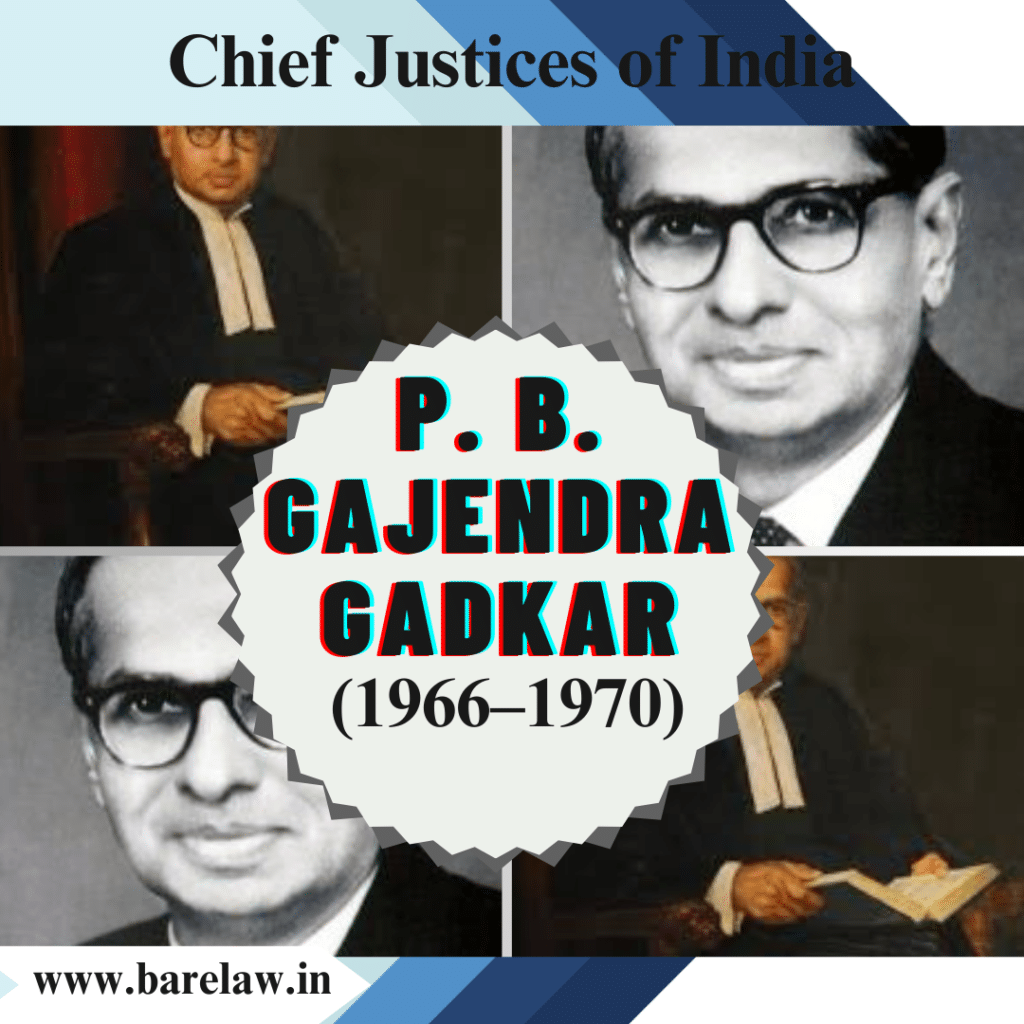
Table of Contents
P. B. Gajendragadkar: The Legacy of India’s Chief Justice (1966–1970)
P. B. Gajendragadkar: The Legacy of India’s Chief Justice (1966–1970)
Introduction
The role of the Chief Justice of India holds immense significance in the nation’s legal landscape. One such notable figure in the history of the Indian judiciary is Justice P. B. Gajendragadkar, who served as the Chief Justice of India from 1966 to 1970. His tenure left an indelible mark on the Indian legal system, marked by landmark decisions, a commitment to constitutional values, and a deep understanding of jurisprudence. This article delves into the life and legacy of Chief Justice P. B. Gajendragadkar, shedding light on his contributions to Indian jurisprudence and the landmark cases that defined his era.
Early Life and Career
Purushottam Bhagwat Gajendragadkar was born on February 12, 1901, in Bombay (now Mumbai), India. He hailed from a family of lawyers and was destined to follow in their footsteps. After completing his education, he embarked on a successful legal career, making a name for himself as a brilliant advocate. His deep knowledge of law and sharp intellect soon gained him recognition in legal circles.
Gajendragadkar’s career in the judiciary began when he was appointed as a Judge of the Bombay High Court in 1948. He continued to ascend the judicial ladder, becoming the Chief Justice of the Bombay High Court in 1958. His tenure in Bombay was marked by a commitment to justice and fairness, laying the foundation for his future role on the national stage.
Appointment as Chief Justice of India
In 1966, P. B. Gajendragadkar reached the zenith of his legal career when he was appointed as the Chief Justice of India. This appointment came at a crucial juncture in India’s history. The nation was grappling with numerous legal and constitutional challenges, and Gajendragadkar’s leadership was instrumental in navigating these complexities.
Landmark Cases and Constitutional Interpretation
During his tenure as Chief Justice, P. B. Gajendragadkar presided over several landmark cases that left a lasting impact on Indian jurisprudence. One of the most notable cases was the Golaknath case (1967), where the Supreme Court grappled with the question of whether Parliament had the power to amend fundamental rights. Gajendragadkar and the Supreme Court held that Parliament could not abridge or take away fundamental rights through constitutional amendments. This decision reinforced the sanctity of fundamental rights in India’s constitutional framework.
Another landmark case during his tenure was the famous Kesavananda Bharati case (1973), which further elaborated on the relationship between Parliament’s amending power and fundamental rights. While the case was decided after Gajendragadkar’s retirement, his earlier judgments laid the foundation for the principles enunciated in Kesavananda Bharati, which ultimately upheld the doctrine of the basic structure of the Constitution.
Gajendragadkar’s approach to constitutional interpretation was characterized by a deep reverence for the Constitution and its values. He believed in a dynamic and purposive interpretation of the Constitution, which allowed it to evolve with changing times while preserving its core principles. His judgments reflected a commitment to protecting individual liberties and upholding the rule of law.
Contributions to Jurisprudence
Chief Justice Gajendragadkar’s tenure also saw significant contributions to the development of jurisprudence in India. He was known for his erudition and meticulous reasoning in his judgments. His commitment to legal principles and the rule of law earned him respect from legal scholars and practitioners alike.
One of his notable contributions was his emphasis on the importance of judicial restraint. He believed that the judiciary should exercise its powers judiciously and refrain from encroaching on the domain of the executive and legislative branches unless absolutely necessary to protect constitutional values. This approach has continued to influence the Indian judiciary’s thinking on the separation of powers.
Legacy and Retirement
P. B. Gajendragadkar’s retirement from the position of Chief Justice of India in 1970 marked the end of an illustrious career in the judiciary. His legacy, however, endured. He continued to be an influential figure in legal circles, delivering lectures, writing on legal topics, and contributing to the discourse on constitutional law and jurisprudence.
His retirement did not signal a withdrawal from public life; instead, it allowed him to engage in scholarly pursuits and share his wisdom with the legal community. His speeches and writings continued to shape legal thinking in India, making him a revered figure long after his retirement.
Conclusion
Justice P. B. Gajendragadkar’s tenure as the Chief Justice of India from 1966 to 1970 stands as a testament to his unwavering commitment to justice, constitutional values, and the rule of law. His landmark decisions and contributions to jurisprudence continue to be cited and revered by legal scholars and practitioners. His legacy is one of principled jurisprudence, constitutional interpretation, and a deep understanding of the Indian legal system.
As India’s legal landscape continues to evolve, the legacy of Chief Justice Gajendragadkar remains a source of inspiration for those who seek to uphold the principles of justice, liberty, and equality enshrined in the Constitution of India. His life and work serve as a reminder of the enduring importance of an independent and principled judiciary in a democratic society.
In honoring the legacy of P. B. Gajendragadkar, we celebrate not only a Chief Justice but also a guardian of India’s constitutional values and a champion of the rule of law. His contributions continue to shape the course of Indian jurisprudence and inspire future generations of legal scholars and practitioners.
References:
- Datar, Arvind P. “Judges of the Supreme Court of India: 1950–1989.” Eastern Book Company, 2005.
- Choudhry, Sujit, and Madhav Khosla. “The Kesavananda Case and the Basic Structure Doctrine.” Oxford Scholarship Online, 2021.





